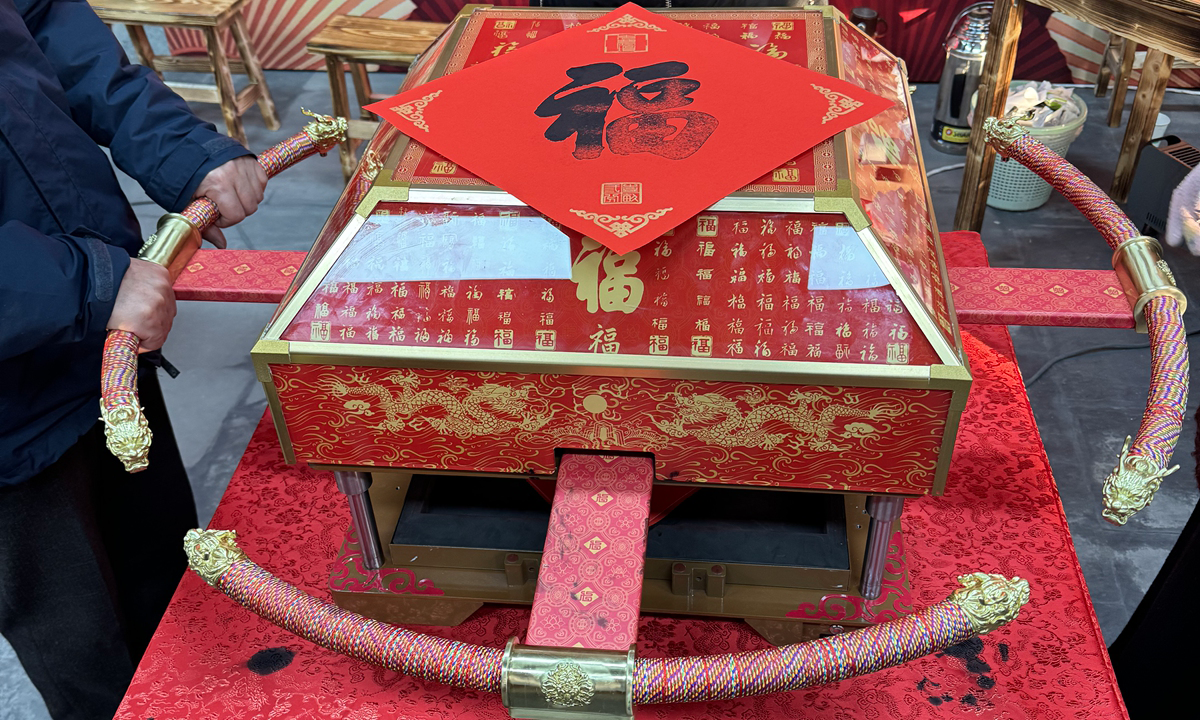
Visitors take part in a fu printing activity at the Beijing Museum of Ancient Architecture in Beijing on February 3, 2024. Photo: Bi Mengying/GT
To celebrate the Chinese New Year, which falls on February 10, various celebrations with unique features have kicked off across the country.
Hanging the Chinese character
fu, or "fortune," on doors and walls is one of the most common and important customs when celebrating the festival.
The character, which is traditionally handwritten by calligraphers, embodies people's delight for the festival and their best wishes for the coming year.
In Beijing, visitors lined up to get
fu characters at the Temple of Agriculture, where the Beijing Museum of Ancient Architecture is housed. Visitors could make their own by stamping a red square paper using a giant seal with the character carved into it.
According to Xue Jian, director of the museum, the printing device was an innovative design by the museum and integrates the traditional Chinese printing techniques of woodblock printing and seal carvings.
As 2024 is the Year of the Dragon, the device was decorated in red with golden dragons on the sides as well as handles on each side.
The device requires four visitors to hold the handles on each side and work together to push down the device and stamp the giant seal.
The character itself comes from a
fu character written by the Yongzheng Emperor, the fifth emperor of the Qing Dynasty (1644-1911). Launched on Friday, the activity has drawn many visitors to the museum.
With a history of nearly 600 years, the Temple of Agriculture, or Xiannong Altar, originally built during the Ming Dynasty (1368-1644), is an ancient complex where former emperors worshiped Shennong (the Celestial Farmer) during the Ming and Qing dynasties.
"
Fu is the symbol of the Spring Festival. It is part of Chinese culture as well as an important carrier of inheriting Chinese civilization," said Xue at the launch ceremony of the activity on Friday.
From ancient times to the present, every corner of the Temple of Agriculture contains rich cultural connotations. Now, we hope to pass on this along with the best wishes from the Temple of Agriculture to people across the country, he added.
Spring Festival Couplets, or
chunlian in Chinese, are usually hung on doors and walls together with the
fu character.
As a tradition, a two-sentence, auspicious poem is written on red paper in anticipation of a prosperous Chinese New Year. The tradition is widely practiced in modern cities and rural areas of China, and overseas Chinese communities.
At Wushi county in the Xinjiang Uygur Autonomous Region, a Spring Festival couplets event welcomed the Chinese New Year.
Young people were encouraged to write Spring Festival couplets and send them to family and friends as festival gifts.
According to local authorities, by expressing their feelings with writing brushes, they vigorously promoted the excellence of traditional Chinese culture, popularized the standard written Chinese language and strengthened relationships among residents.
Southwest China's Sichuan Province has launched a series of cultural and tourism activities themed "Thousands of Dragons and Lions Celebrating the New Year, Joyfully Welcoming the Spring Festival," which includes seven major categories and 27 series with more than 1,900 activities to celebrate the Chinese New Year.
For instance, more than 1,780 dragon and lion dance troupes composed of people from different ethnic groups across the province will perform in different venues such as rural areas, local markets, streets and welfare institutions. Various folk cultural art exhibitions will be held throughout the region to inherit local unique folk culture.
Meanwhile, in the Sanjiang Dong Autonomous County, South China's Guangxi Zhuang Autonomous Region, more than 1,200 people from 22 performing teams across the region participated in a "village gala" to celebrate the upcoming holiday.
Performers from different ethnic groups are dressed in their own vibrant traditional clothing to bring the cultural feast to audiences.
The dragon is an ancient totem of the Chinese nation with a long history. In daily life, dragon culture is a living tradition that has been endlessly passed down from generation to generation.
The dragon symbol is the most widely used auspicious art in folk life, Qiao Xiaoguang, director of the Intangible Cultural Heritage Research Center at the Central Academy of Fine Arts, told the Global Times.
People of all ethnic groups across the country have begun to welcome the arrival of the Year of the Dragon in their own unique ways.
The various dragon dance performances we see today in different ethnic areas are the embodiment of dragon civilization.
The celebration of the Spring Festival is not only about celebrating the festival itself, it's also a celebration of the traditions, cultural heritage and ethnic diversity of the country, Qiao added.